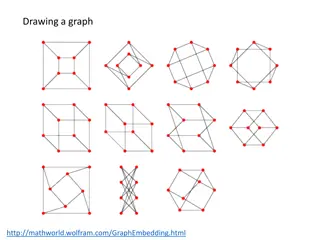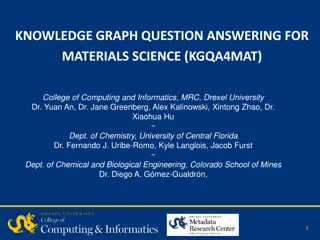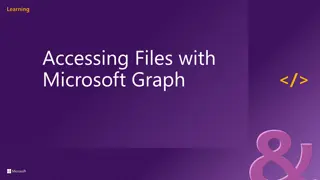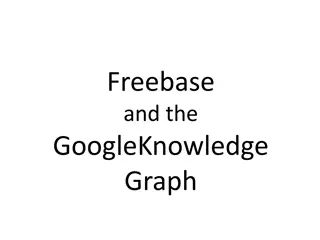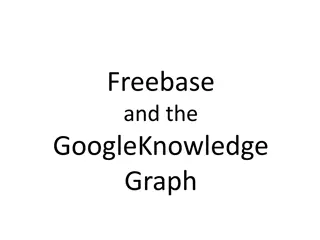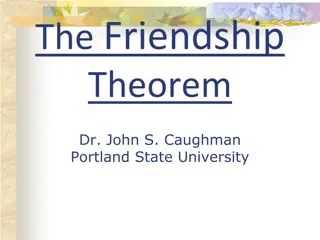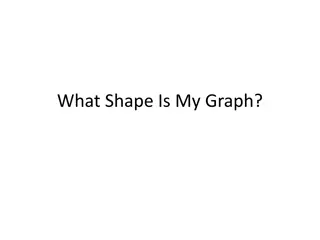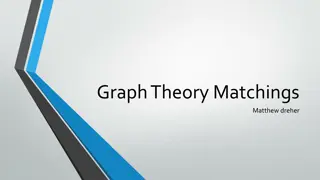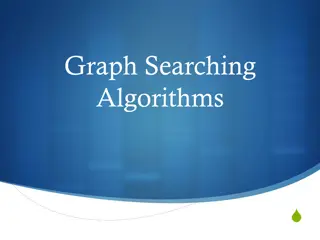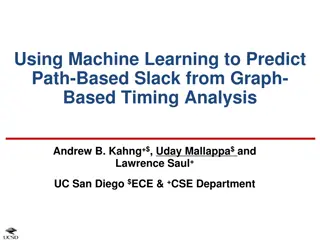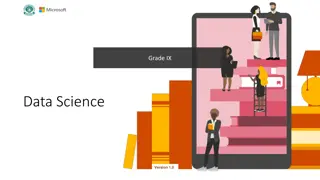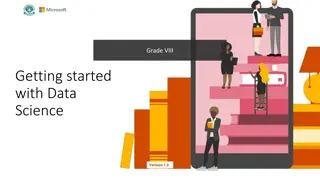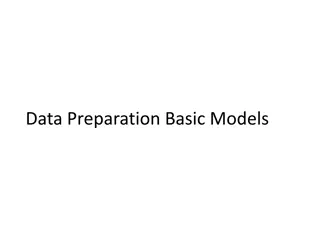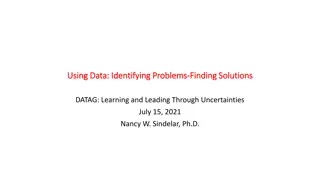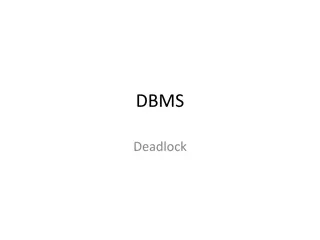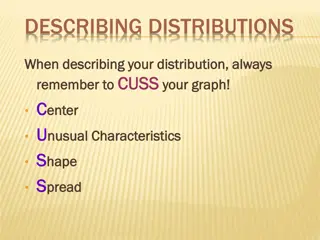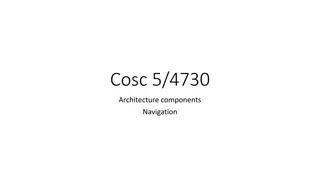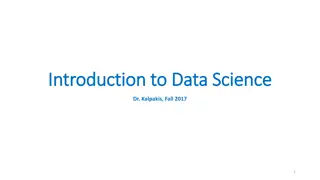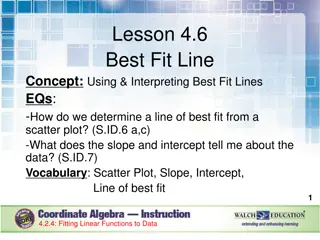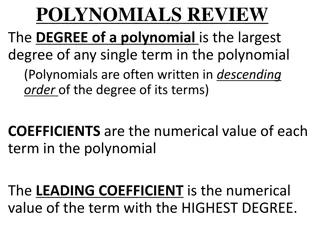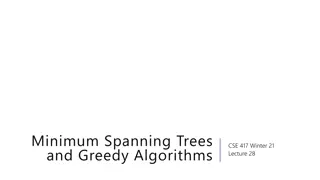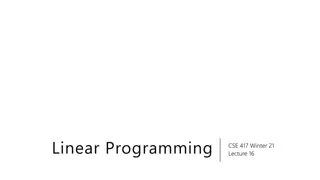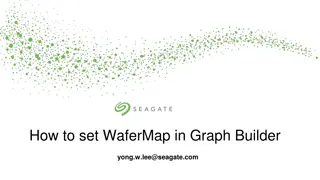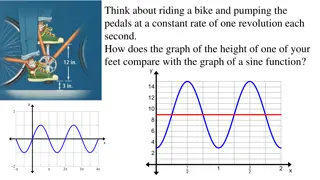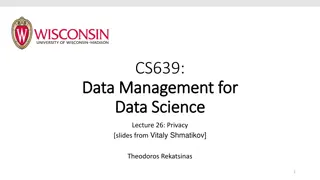Exploring Graph-Based Data Science: Opportunities, Challenges, and Techniques
Graph-based data science offers a powerful approach to analyzing data by leveraging graph structures. This involves using graph representation, analysis algorithms, ML/AI techniques, kernels, embeddings, and neural networks. Real-world examples show the utility of data graphs in various domains like social networks, protein interactions, and financial networks. The combination of querying, statistics, and graph algorithms in graph-based data science enables applications in ML/AI by revealing relationships and patterns within graph data. Techniques such as graph analytics and graph-enhanced ML/AI provide insights into network structures, fraud detection, and influential nodes. Graph queries and statistics help extract valuable information from datasets based on local properties of graph nodes. Explore the potential of graph-based data science for advanced data analysis.
Download Presentation

Please find below an Image/Link to download the presentation.
The content on the website is provided AS IS for your information and personal use only. It may not be sold, licensed, or shared on other websites without obtaining consent from the author. Download presentation by click this link. If you encounter any issues during the download, it is possible that the publisher has removed the file from their server.
E N D
Presentation Transcript
Graph Based Data Science Opportunities, challenges and techniques
Outline Graphs for Data Representation Overview of Graph Based Data Science Graph Analysis Algorithms Graph Aware ML/AI techniques Graph Kernels Graph Embeddings Graph Neural Networks Hands-on graph-based ML/AI example
Graphs for Data Representation1,2,46 A data graph is a mathematical representation of entities (nodes) and their relationships (edges). Why data graphs? they represent data intuitively they make it easier to explore the data a lot of real-world examples are already graph structured**
Graphs for Data Representation1,2 Examples of real-world graph data: WWW, Internet Social Networks Citation networks Protein interaction networks Communication networks Word co-occurrences networks Food webs Financial networks Economic networks Knowledge graphs [55]
Overview of Graph Based Data Science3 Graph based data science combines querying, statistics and graph algorithms to power ML/AI applications by leveraging the relationships and topology of graph data Graph Analytics: uses queries and graph statistics/algorithms** to answer such questions as: how many customers are in a marketing graph? are there any fraud rings in the transaction data? who s the most important influencer in a network? Graph Enhanced ML and AI: uses queries, graph statistics/algorithms and specialized graph aware ML/AI techniques to describe the global topology or connectivity of a data set. The results define graph-based features that are used as input to downstream ML/AI tasks
Overview of Graph Based Data Science3 Graph Queries: retrieve an explicit pattern within the dataset e.g. fetch the names of George s co-authors compute the average salary of a company s employees Graph Statistics: are based on local properties of the graph nodes: Graph size Graph density Degree distribution Local clustering coefficient
Overview of Graph Based Data Science3 Graph Algorithms: employ graph traversals Connected Components: identify strongly connected subgraphs Community Detection: partition a graph based on relationships Centrality: reveal which nodes are important based on graph topology Node Similarity: identify similar nodes based on their neighbors or properties Pathfinding: find the shortest or most efficient paths to traverse a graph Link Prediction: predict unobserved or future relationships between nodes** Some of the graph algorithms employ ML techniques themselves!
Graph Algorithms Connected Components5 Undirected Graph: Breadth First Search Depth First Search Directed Graph: Weakly Connected Components: discard edge directions and proceed as before Strongly Connected Components: Kosaraju's algorithm57 Use Cases Image Processing29 Entity Resolution/deduplication Cybersecurity30 Fraud Detection etc.
Graph Algorithms Community Detection11 Algorithms: Louvain6 Label Propagation7 many more8 Use Cases: Social networks analysis: e.g., extracting topics from online social platforms9 Criminology: identification of groups in criminal networks Public Health: discover dynamics of certain groups susceptible to an epidemic disease Customer Segmentation: identify groups of people that are using the same financial service Bioinformatics: investigating the human brain and finding hierarchical community structures within the brain s functional network10 etc.
Graph Algorithms Node Similarity Based on: Node s own features Node s own and neighbors ID/features Similar neighbors (recursive definition) Graph topology Any combination of the above Use cases: Entity matching/resolution31 Recommendations (e.g., Customers who brought this item also brought.. ) etc.
Graph Algorithms Centrality11 Variations: Degree Centrality: nodes with lots of direct connections Closeness Centrality: nodes that can reach other nodes with few hops Betweenness Centrality: nodes that sit on the shortest path of lots of pairs of other nodes Eigenvector Centrality: nodes that are transitively connected to other important nodes Use Cases: Identification of social media influencers12,13 Fighting fraud and terrorism14,15,16 Predicting flow in traffic, delivery and telecommunications systems17,18 etc.
Graph Algorithms Path Finding5 Algorithms Shortest Path A* Yen s k-shortest paths All pairs shortest path Single source shortest path Minimum Spanning Tree Random Walks Use cases Directions between two physical locations Degrees of separation between people Travel Planning20, 21 Financial Analysis19 Graph Embeddings** etc.
Graph Kernels32 Graph Kernels can be intuitively understood as functions quantifying the similarity of pairs of graphs. Kernel based on shortest paths: Sim (G1, G2) = 0.98 Sim (G2, G3) = 0.90 Sim (G1, G3) = 0.86 G2 G1 G3
Graph Kernels32,33 What is a graph kernel? Map two graphs g1 and g2 using mapping into feature space Measure their similarity in as < (g1), (g1)> Actualize kernel trick: devise kernel function k such k(g1, g2) = < (g1), (g1)>
Graph Kernels32,33 Requirement for graph kernel functions: Positive definite (in order to be a valid kernel function) Expressive define a non-trivial measure of similarity on graphs represent subgraph features that allow to tell if the topology, node and edge labels of two graphs are similar Applicable to a wide range of graphs Efficient to compute
Graph Kernels32,33 Graph Kernel variants34: graph kernels take the form of an aggregation over metrics that describe different aspects of the graph topology: based on local structure: two graphs are similar if they are composed of nodes with similar neighborhoods graph components: compare graphs by identifying the best possible matching of the components making up the graphs (nodes, labels, edges, subgraphs etc.) paths and walks: compare sequences of node or edge attributes encountered through graph traversals (e.g., shortest paths, random walks)
Graph Kernels32,33 Applications of Graph Kernels: ML/AI Allow kernelized ML algorithms (e.g., SVMs) to work directly on graphs Can be employed to learn node embeddings41** Chemoinformatics : predicting the toxicity of chemical molecules37 Drug discovery: virtual screening36 Bioinformatics : protein function prediction35 Web data mining and Social Networks: node classification39, 40 link prediction38, 40 etc.
Graph Embeddings22 Embedding in ML/AI consists of representing complex objects like text, images or graphs with continuous vectors of a reduced dimensionality compared to the dimensionality of the dataset, while keeping the most important information about them.
Graph Embeddings22 Graph embeddings should capture the graph topology, node-to-node relationships, and content information. Node embeddings Whole graph embeddings [23]
Node Embeddings24 Each node is represented with a continuous vector of a fixed dimensionality. They are used to perform visualization or prediction at the node level, e.g., link prediction. Popular techniques: Random Walk Based Approaches: DeepWalk42 : uses random walks to produce embeddings node2vec 43 : modification of DeepWalk that provides control over the explored neighborhoods Deep Learning Approaches GraphSAGE 45: an inductive scalable technique Graph Neural Networks**
Node Embeddings24 DeepWalk42 1. 2. The graph is sampled using random walks A skip-gram (MLP) network accepts a node from the random walk as a one-hot vector as an input and maximizes the probability for predicting neighbor nodes 3. The node embedding is the output of the last hidden layer of the network
Node Embeddings24 node2vec43:modified random walks to better user exploration requirements Each random walk accepts two (additional) parameters: Q: controls the likehood to discover the undiscovered part of the graph P: controls the likehood to return to the previous node
Node Embeddings24, 47, 48 GraphSAGE45: learns aggregator functions that can induce the embedding of a previously unseen node (thus inductive technique) given its features and neighborhood. It consists of two main components: Context construction Information Aggregation
Node Embeddings24, 47, 48 GraphSAGE45 Context construction the neighborhood of a node consists of the nodes up to K hopes away form that node Assumption: nodes that reside in the same neighborhood should have similar embeddings
Node Embeddings24, 47, 48, 49 GraphSAGE45 Information Aggregation instead of learning node embeddings GraphSAGE learns aggregation functions aggregation functions accept a neighborhood as input and combine each neighbor s embedding with weights to create a neighborhood embedding: LSTM on a random permutation of the nodes in a neighborhood average MLP followed by max pooling
Whole Graph Embeddings24 The entire graph is represented with a single vector. They are used to make predictions at the graph level or to compare or visualize graphs, e.g., in the comparison of chemical structures. graph2vec25: unsupervised technique with relatively stable performance Many other techniques but no clear winners: sub2vec (embed subgraphs)27: produces subgraph embeddings UGRAPHEMB28: an inductive method
Whole Graph Embeddings24 graph2vec25: views the graph as a document and the rooted subgraphs around every node as words that compose the document. It is trained to maximize the probability of predicting subgraphs:
Graph Neural Networks50,51,53,55 Graph Neural Networks (GNNs) are connectionist models that capture the relationships represented in the graphs: there is one GNN recurrent unit for each node in the graph: each unit maintains stateful information (embeddings) that captures the properties of the related node the neighborhood properties of that node
Graph Neural Networks50,51,53,55 Graph Neural Networks (GNNs) are connectionist models that capture the relationships represented in the graphs: an MLP for each edge learns the importance/properties of the underlying relation
Graph Neural Networks50,51,53,55 Graph Neural Networks (GNNs) are connectionist models that capture the relationships represented in the graphs: neighborhood aggregation is employedto identify the dependencies between the nodes of graphs
Graph Neural Networks50,51,53,55 Graph Neural Networks (GNNs) are connectionist models that capture the relationships represented in the graphs: once neighborhood aggregation is performed the node embeddings capture more accurately the information about their own features and that of their neighboring nodes the vector H that results by taking the sum of all the node embeddings represents the whole graph
Graph Neural Networks52,53,54 Applications of GNNs: ML/AI Node classification Link Prediction Physical Systems: model Interaction Networks and predict future trajectories Chemistry: more flexible means to predict the properties of a new molecule by learning from example molecules predict side effects due to drug interactions Image Classification: alternative to CNNs to achieve zero-shot or few-shot learning Combinatorial Optimization: have shown promise as alternatives to relaxation-based techniques Social graphs: content recommendation Transportation: traffic prediction etc.
Hands-on graph-based ML/AI example https://bitbucket.org/diip20201/tutorials/src/master/graph_based_data_science/
References 1. https://towardsdatascience.com/graph-databases-whats-the-big-deal-ec310b1bc0ed 2. https://snap.stanford.edu/data/ 3. https://neo4j.com/blog/announcing-neo4j-for-graph-data- science/#:~:text=Graph%20data%20science%20uses%20multidisciplinary,artificial%20intelligence%20(AI)%20applications. 4. https://neo4j.com/blog/how-graphs-enhance-artificial-intelligence/ 5. Alfred V. Aho, John E. Hopcroft and Jeffrey D. Ullman. Data Structures and Algorithms. Addison-Wesley, 1983 6. H. Lu, M. Halappanavar and A. Kalyanaraman: Parallel Heuristics for Scalable Community Detection, Parallel Computing, vol. 47, pp. 19-37, 2015 7. X. Zhu and Z. Ghahramani: Learning from Labeled and Unlabeled Data with Label Propagation, CMU CALD tech report CMU-CALD-02-107, 2002 8. J. Leskovec, K. J. Lang and M. W. Mahoney: Empirical Comparison of Algorithms for Network Community Detection, WWW 2010 9. G. S. Kido, R. A. Igawa and R. C. Garcia: Topic Modeling based on Louvain method in Online Social Networks, SBSI 2016 10. D. Meunier, R. Lambiotte, A. Fornito, K. D. Ersche, and Edward T. Bullmore: Hierarchical Modularity in Human Brain Functional Networks, Frontiers in Bioinformatics, 2009 11. https://neo4j.com/developer/graph-data-science/centrality-graph-algorithms/ 12. https://www.brandwatch.com/blog/react-influential-men-and-women-2017/ 13. S. Wu, L. Gong, W. Rand and L. Raschid, Making recommendations in a microblog to improve the impact of a focal user, SSRN Electronic Journal, 2002 14. V. E. Krebs: Mapping Networks of Terrorist Cells, Connections 2002 15. P. Bangcharoensap, H. Kobayashi, N. Shimizu, S. Yamauchi and T. Murata: Two Step graph-based semi-supervised Learning for Online Auction Fraud Detection, ECML PKDD 2015 16. C. Morselli and J. Roy: Brokerage qualifications in ringing operations, Criminology 2008 17. S. P. Borgatti: Centrality and Network Flow, Social Networks 2005 18. B. Jiang, S. Zhao and J. Yin: Self-organized Natural Roads for Predicting Traffic Flow: A Sensitivity Study, Journal of Statistical Mechanics Theory and Experiment 2007 19. T. T. Chitenderu: The Random Walk Theory And Stock Prices: Evidence From Johannesburg Stock Exchange, IBER 2014
References 20. T. Chondrogiannis, P. Bouros, J. Gamper and U. Leser: Alternative Routing: k-Shortest Paths with Limited Overlap, SIGSPATIAL 2015 21. L. Fitina, J. Impal, V. Uiari, N. Murki and E. Goodyear: An Application of Minimum Spanning Trees to Travel Planning, DWU Research Journal 2010 22. https://medium.com/@st3llasia/graph-embedding-techniques-7d5386c88c5 23. W. L. Hamilton, R. Ying and J. Leskovec: Representation Learning on Graphs: Methods and Applications, IEEE Data Engineering Bulletin 2007 24. https://towardsdatascience.com/graph-embeddings-the-summary-cc6075aba007 25. A. Narayanan, M. Chandramohan, R. Venkatesan, L. Chen, Y. Liu, and S. Jaiswal: graph2vec: Learning Distributed Representations of Graphs, MLG 2017 26. M. Niepert, M. Ahmed, K. Kutzkov: Learning Convolutional Neural Networks for Graphs ICML 2016 27. B. Adhikari, Y. Zhang, N. Ramakrishnan and B. A. Prakash: Sub2Vec: Feature Learning for Subgraphs, PAKDD 2018 28. Y. Bai, H. Ding, Y. Qiao, A. Marinovic, K. Gu, T. Chen, Y. Sun and W. Wang: Unsupervised Inductive Graph-Level Representation Learning via Graph-Graph Proximity, IJCAI 2019 29. W. Song, D. Wu, Y. Xi, Y. W. Park, and K. Cho, Motion-based skin region of interest detection with a real-time connected component labeling algorithm, Multimedia Tools and Applications, 2016. 30. M. Yip, N. Shadbolt, and C. Webber, Structural analysis of online criminal social networks, Intelligence and Security Informatics, 2012 31. M. Pershina, M. Yakout, K. Chakrabati: Holistic Entity Matching Across Knowledge Graphs, BigData 2015 32. https://sites.cs.ucsb.edu/~xyan/tutorial/KDD08_graph_partII.pdf 33. https://d-nb.info/985213434/34 34. https://arxiv.org/pdf/1903.11835.pdf 35. K. M. Borgward, C. S. Ong, S. Sch nauer, S. V. N. Vishwanathan, A.J Smolaand H.-P. Krigel: Proteinfunctionpredictionvia graph kernels, Bioinformatics2005 36. M. P. Preeja and S. Kp: Walk-based Graph Kernel for Drug Discovery: A Review, International Journal of Computer Applications 2014 37. http://www.normastic.fr/wp-content/uploads/2019/05/presentation-03.05.2019.pdf
References 38. W. Yuan, K. He, D. Guan, L. Zhou and C. Li: Graph kernel based link prediction for signed social networks, Information Fusion 2019 39. N. Bui and V. Honavar: Labeling Actors in Social Networks Using a Heterogeneous Graph Kernel, SBP 2014 40. U. Losch, S. Bloehorn and A. Rettinger: Graph Kernels for RDF Data, ESWC 2012 41. Y. Tian, L. Zhao, X. Peng and D. N. Metaxas: Rethinking Kernel Methods for Node Representation Learning on Graphs, NeurIPS 2019 42. B. Perozzi, R. Al-Rfou and S. Skiena: Deep Walk: Online Learning of Social Representations, KDD 2014 43. A. Grover and J. Leskovec: node2vec: Scalable Feature Learning for Networks, KDD 2016 44. D. Wang, P. Cui, W. Zhu: Structural Deep Network Embedding, KDD 2016 45. W. L. Hamilton, R. Ying, and J. Leskovec: Inductive Representation Learning on Large Graphs, NIPS 2017 46. https://www.kaggle.com/ferdzso/knowledge-graph-analysis-with-node2vec 47. https://towardsdatascience.com/an-intuitive-explanation-of-graphsage-6df9437ee64f 48. http://snap.stanford.edu/graphsage/ 49. https://medium.com/analytics-vidhya/ohmygraphs-graphsage-and-inductive-representation-learning-ea26d2835331 50. https://towardsdatascience.com/a-gentle-introduction-to-graph-neural-network-basics-deepwalk-and-graphsage-db5d540d50b3 51. F. Scarselli, M. Gori, A. Tsoi, M. Hagenbuchner and G. Monfardini: The graph neural network model, IEEE Transactions on Neural Networks, 20(1) 2009 52. https://towardsdatascience.com/https-medium-com-aishwaryajadhav-applications-of-graph-neural-networks-1420576be574 53. J. Zhou, G. Cui, Z. Zhang, C Yang, Z. Liu, L. Wang, C. Li, M. Sun: Graph Neural Networks: A Review of Methods and Applications, ArXiv 2018 54. https://blog.fastforwardlabs.com/2019/10/30/exciting-applications-of-graph-neural-networks.html 55. https://medium.com/dair-ai/an-illustrated-guide-to-graph-neural-networks-d5564a551783 56. N. Shervashidze, P. Schweitzer, E. J. van Leeuwen, K. Mehlhorn and K. M. Borgwardt: Weisfeiler-Lehman Graph Kernels, Journal of Machine Learning Research 12 (2011) 57. https://en.wikipedia.org/wiki/Kosaraju%27s_algorithm










